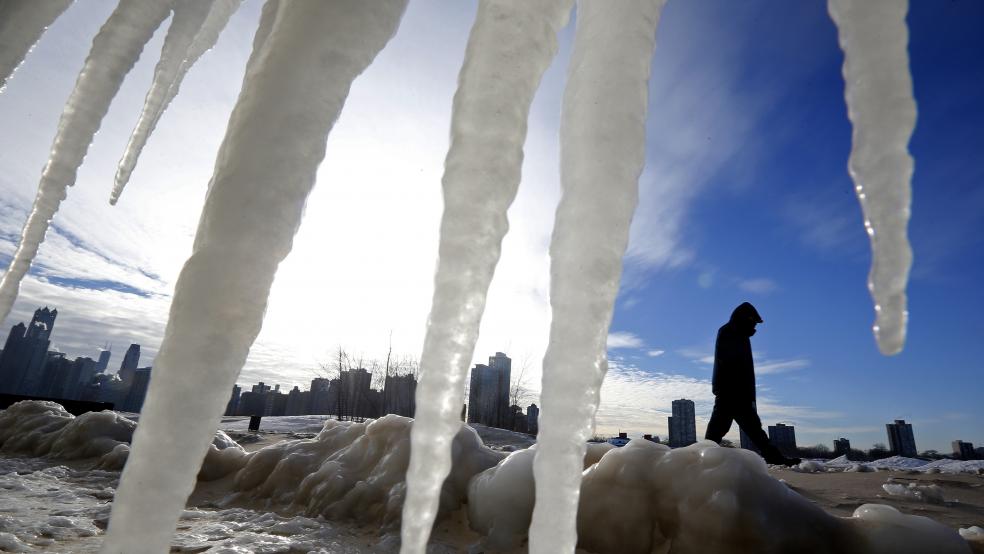Manufacturing output in the U.S. unexpectedly fell in January, recording its biggest drop in more than 4-1/2 years, as cold weather disrupted production in the latest indication the economy got off to a weak start this year.
Though consumer sentiment was steady in early February, there are worries the harsh weather, which has persisted in many parts of the country, could dampen the morale of households when it starts to stretch budgets through high bills for heating.
Related: Is This Storm a Valentine's Day Heartbreaker?
"The big question is whether the U.S. economy is slowing significantly or whether it is merely going through a soft patch caused by extreme weather. The evidence points to the latter," said Chris Williamson, chief economist at Markit in London.
Factory production fell 0.8 percent last month, the Federal Reserve said on Friday. It was the first drop since July and the biggest since May 2009, when the economy was still locked in recession. Output had increased 0.3 percent in December. The Fed attributed the first decline in factory output since July to "severe weather that curtailed production in some parts of the country." Economists polled by Reuters had expected manufacturing output to edge up 0.1 percent.
A separate report showed the Thomson Reuters/University of Michigan overall index of consumer sentiment stood at 81.2 early this month, unchanged from January. The survey's barometer of current economic conditions fell to 94.0 from 96.8 in January.
"The good news is that confidence proved resilient to recent government reports of weak growth in income and employment," survey director Richard Curtin said. "The not-so-good news is that the full impact on household budgets from the harsh winter has yet to be registered."
Related: State and City Budgets Walloped by Winter Weather
Manufacturing joined weak retail sales and employment data in suggesting that cold weather had spurred a step-back in economic growth early in the first quarter. Growth is also slowing after a strong performance in the second half of 2013.
The flow of weak data come as the U.S. central bank reduces its monetary stimulus. But given the distortions from the weather, economists believe the Fed will continue to taper its monthly bond purchases at its policy meetings this year.
Investors on Wall Street shrugged of the manufacturing report, sending U.S. stocks higher. Prices for U.S. Treasury debt fell and the dollar was trading marginally lower against a basket of currencies.
Auto Production Tumbles
The weakness in factory output last month was broad-based, with the production of motor vehicles and parts tumbling 5.0 percent after ticking up 0.1 percent in December.
"The inclement weather in January contributed to some of these decreases. Numerous motor vehicle assembly facilities lost one or more days of production during the month," the Fed said in a statement.
Related: Extreme Weather Could Chill the Economy
Apart from the poor weather, auto manufacturers are also likely cutting back on production after a sharp increase in motor vehicle inventories in the fourth quarter. That situation has been exacerbated by a decline in sales in December and January.
While manufacturing output accelerated in the fourth quarter, the pace was not as strong as previously thought. Fourth-quarter output at the nation's factories was lowered to a 4.6 percent annual rate from a 6.2 percent pace.
"This may be an early sign demand was already slowing even before 2014 began," said Jay Morelock, an economist at FTN Financial in New York.
The drop in factory output last month and a 0.9 percent fall in mining activity weighed on overall production, which fell 0.3 percent, the biggest drop since April. Mining output was also hampered by cold weather, which caused slowdowns at some oil and gas extraction facilities.
Production at the nation's mines, factories and power plants had increased 0.3 percent in December. But freezing temperatures boosted demand for heating last month, causing utilities production to jump 4.1 percent. In January, the amount of industrial capacity in use fell to 78.5 percent from 78.9 percent in the prior month.
Industrial capacity utilization, a measure of how fully firms are using their resources, was 1.6 percentage points below its long-run average.
Officials at the Fed tend to look at utilization measures as a signal of how much "slack" remains in the economy, and how much room growth has to run before it becomes inflationary.
With additional reporting by Steven C. Johnson of Reuters in New York.



